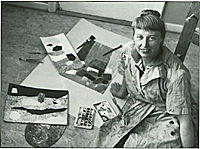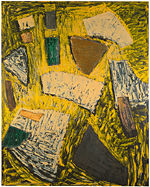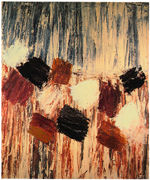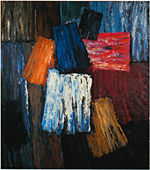

Nature Abstractions 1957-1967
By Adalsteinn Ingólfsson
In 1949 Nína Tryggvadóttir seemed to have everything going for her. She had enjoyed a more thorough and varied artistic schooling than any other Icelandic artist. As a youngster she had been taught drawing by Ásgrímur Jónsson, one of the pioneers of Icelandic art, and gone on to study in the private art school run by painters Finnur Jónsson and Jóhann Briem. Like so many of her countrymen, Tryggvadóttir had subsequently gravitated to the Royal Academy of Art in Copenhagen, where she studied under the venerable Danish painter Kræsten Iversen for four years.
From there Tryggvadóttir went to New York in 1942, where she took classes with some of the city’s most influential teachers, Hans Hofmann, Hans Richter and Morris Kantor, as well as benefiting from the advice of Fernand Léger, exiled to New York for the duration of the war. These teachers differed profoundly both in their art and approach to teaching.
Hofmann was of course a thoroughgoing Modernist with expressionist leanings, Léger had evolved his own brand of monumental Cubism, Richter was an old Dadaist and a pioneer of experimental filmmaking and Kantor was a figurative painter with surrealist leanings. Tryggvadóttir formed a lasting friendship with all of these teachers, as is evidenced by her correspondence, now in the keep of her daughter, Una Dóra Copley.
In New York Tryggvadóttir made the acquaintance of J. B. Neumann, the discerning head of the New Art Circle, who regularly organised shows of Dufy, Gris, Klee, Gromaire, Rouault and Soutine. Neumann offered Tryggvadóttir her first New York show in 1945 and again in 1948. Both shows were a success, the second one in particular. Most of Tryggvadóttir’s pictures were sold and Elaine de Kooning, who was making a name for herself as a critic, gave the show a highly favourable review in Art News (Art News, 4, 1948).
In the aftermath of the 1945 show Tryggvadóttir was invited to design both scenery and costumes for a new production of Stravinky’s Soldier’s Tale, conducted by Dmitri Mitropolous, an important figure in U.S. musical life. Mitropolous had a hand in launching the young Leonard Bernstein at about the same time. The new production, complete with Tryggvadóttir’s stage and costume design, was well received both by critics and the public.
The first New Art Circle show also brought Tryggvadóttir together with a German-American medical scientist, Alfred L. Copley, and the second New Art Circle show served to cement their relationship. Copley was unusual in that he had an alter ego named L. Alcopley, who moved in large circles of artists and intellectuals.
The two of them gradually fell in love, and through Alcopley Tryggvadóttir gained access to an ‘inner circle’ of taste-makers who were just about to transform American cultural life.
Tryggvadóttir and Alcopley were married on April 16th, 1949. The same year Alcopley and eleven other artists founded The Club, a forum for discussions as well as an informal meeting place for artists, which met every Friday in an 8th Street loft. The Club’s gatherings were attended by artists such as de Kooning, Kline, Ibram Lassaw, Marca-Relli, Alexander Calder and others, critics like Clement Greenberg, museum chief Alfred J. Barr Jr., a future collector and gallerist by the name of Leo Castelli and art historian Meyer Schapiro (see One Man–Two Visions, L. Alcopley – A.L. Copley, Artist and Scientist, ed. Alexander Silberg, Pergamon Press, Oxford-New York-Seoul-Tokyo, 1993, pp. 91-95). The last named already knew of Iceland and Icelanders through a former student at Columbia University, Selma Jónsdóttir, future Director of the National Gallery of Iceland. Tryggvadóttir also had access to the Icelandic-American art historian Harvard Arnason, who was making a name for himself at the Guggenheim. Tryggvadóttir and Alcopley were also on friendly terms with composers, philosophers, dancers and writers such as Edgar Varèse, Hannah Arendt, Heinrich Blücher, Frederik Kiesler, Eric Hawkins and Anaïs Nin. According to Alcopley he was on one occasion able to save the life of Dylan Thomas, who was just about to exit drunkenly through a third storey window during one of the meetings of The Club (op. cit., p. 197).
Tryggvadóttir had also progressed steadily in her art. By 1949 she had developed a style of concise, highly textured, almost sculpted planes and warm colours, which appealed both to her Icelandic admires and American critics of her work. It was a style which bypassed the Surrealist and Primitivist effects which some of her colleagues at The Club had incorporated into their increasingly abstract canvases. Tryggvadóttir did, however, have at least one thing in common with some of her American painter friends, namely the desire to turn abstract or semi-abstract art, so long in the thrall of formalism, into a vehicle for exalted ideas and passions. Thus the American art scene had much to offer Tryggvadóttir, who must have looked forward to settling here for good with her husband.
Nothing seemed to be in the way of her doing just that. On the 16th of August 1949 Tryggvadóttir left New York for Iceland in order to fetch her belongings, see her relatives and conclude other business before taking up residence in New York. On December 7th, 1949, shortly before she was due to leave for New York, Tryggvadóttir was summoned to the U.S. Legation in Reykjavik. There an official informed her that she would not be admitted into the United States, even though she was married to an American citizen, the reason being that she was suspected of being a Communist sympathiser. (Most of the information on these events, including dates, is to be found in the archive of Nína Tryggvadóttir’s and L. Alcopley’s letters, now in the possession of her daughter, Una Dóra Copley, in New York.)
After many weeks of letter-writing, petitions and telephone inquiries, Tryggvadóttir’s patience snapped. In despair, and without a visa, she boarded a plane for New York on February 3rd 1950. She was detained as soon as she landed at Idlewild airport and sent to Ellis Island for a period of ten days, after which she was put back on a plane to Iceland.
This is the beginning of the most peculiar and tragicomic episode in the long history of Icelandic-American cultural relations, an episode which will not be recounted here in any detail. Essentially what happened was that some conscientious witch hunters at the U.S. Legation in Reykjavik, fuelled by Cold War hysteria and seemingly abetted by Icelandic informers, had passed on to the appropriated authorities in Washington the following information:
1. Ms. Tryggvadóttir associates with a lot of Icelandic communists, thus she must be a communist herself.
2. Ms. Tryggvadóttir had written and illustrated a book, The Flying Fish Story (1948), supposedly intended for children but actually containing clever anti-American propaganda.
3. Ms. Tryggvadóttir had been indiscreet enough to say, in the presence of a U.S. Legation official, that she much preferred Trotsky to Stalin.
These charges sound ridiculous enough today but they seemed to close the Unites States to Tryggvadóttir for a period of almost eight years. Dozens of supposedly influential Icelanders, among them some of the leading lights of the very pro-American Independence Party, testified to the artist’s unconcern with political affairs of any kind, and Tryggvadóttir’s American friends and contacts did the same, including gallery owner J. B. Neumann, fellow Icelandic artist Louisa Matthíasdóttir and Hans Hofmann. Letters were written to officials in the U.S. Department of Immigration, to the respective Ambassadors of Iceland and the Unites States, to the U.S. Secretary of State, to Eleanor Roosevelt, even to President Harry Truman – but to no avail (See archive of letters).
Tryggvadóttir waited and worked in Iceland until 1952, when it seemed clear that the original decision by the U.S. Immigration authorities would not be revoked. Alcopley then decided to give up his job with the U.S. Atomic Commission in order to go with his wife into ‘exile’ in Paris, where he had found a job as a medical researcher in a hospital. The couple lived in Paris with their young daughter, born in Iceland in 1951, until the spring of 1957. Late in 1957 Tryggvadóttir was at last informed by U.S. officials in Paris that it was safe for her to apply for a visa. By then Alcopley had contracted to work in London for two years so that their return to New York was delayed until December 1959. Thus Tryggvadóttir did not set foot in New York for a period of ten years.
There’s been a tendency to see these events simply as an ‘inconvenient’ episode in Tryggvadóttir’s life, not least because of her disinclination to talk about it in public. Which does not mean that she didn’t think it was important. But the effect of her blacklisting was really more serious than has been realised. Tryggvadóttir was in effect summarily removed from the American art scene, which was just about to enter its influential Abstract-Expressionist phase, and made to ply her art in quite another, and arguably more conservative, cultural context on the European continent.
Its is of course quite pointless to speculate as to how Tryggvadóttir’s art would have progressed, had she been able to carry on her work in New York at that crucial point in time, to observe the artistic development and escalating careers of friends and aquaintances such as Hofmann, Kline and de Kooning. Nevertheless, I would like to hazard the guess that she would have bypassed the Concrete phase that she flirted with from 1951-54 – Concrete Art being essentially an European rather than an American phenomenon – and gone straight on to a more Expressionist phase.
I am also convinced that Tryggvadóttir’s absence from New York, for two decades, effectively put an end to her career in the United States, which in 1949 seemed to be taking off. Shortly after Tryggvadóttir’s return in 1959, it was clear that any leading critics, gallery people and museum professionals in New York had lost touch with her art and its development during the preceding decade. It is then that we see the emergence of the rather persistent misconception that Tryggvadóttir, having participated in the French art scene for a period of time, had developed into a follower of either Nicholas de Staël, Sergei Poliakoff, or both. Both de Staël and Poliakoff were known for their textured compositions, involving blocks of colour. Tryggvadóttir had been working with just such blocks ever since her 1939 sojourn in Paris.
As far as I know, this misconception first surfaced in 1961 when Tryggvadóttir offered two of her recent paintings for sale to the Museum of Modern Art. M.O.M.A. had shortly before purchased paintings by Icelandic painters Jóhannes Kjarval and Svavar Gudnason and accepted a gift of a painting of Tryggvadóttir’s from a private donor (see Alfred H. Barr, Jr.: Painting and Sculpture in the Museum of Modern Art, 1926-1927, M.O.M.A., New York 1977). For six months the artist received no answer from the trustees of the museum. In the end Tryggvadóttir wrote to M.O.M.A.’s Director, her old friend Alfred J. Barr, Jr., to inquire after the fate of her paintings. Barr seems to have answered her letter sometime in December 1961, outlining the ‘problem’ facing the trustees with regard to her work in general. Tryggvadóttir’s subsequent letter to Barr, dated January 2nd, 1962, leaves us in doubt as to the nature of the ‘problem’.
I am enclosing a copy of Michel Seuphor’s little book on my works in the hope to clear up the misconception which these committee members seem to have about the origin of the ideas in my paintings. It as been rather unfortunate for me that my work which precedes that of De Staël or of Polyakoff [sic] did not receive the proper attention before the work of these two artists become known.(See archive of letters.)
Tryggvadóttir goes on to encapsulate her exhibition record and mentions that she was showing her mature work in Neumann’s gallery both in 1945 and 1948, whereas De Staël’s work was not exhibited in New York until 1950. Thus, she says, de Staël could just as well have been influenced by her, rather than the other way round. Interestingly enough, Tryggvadóttir only mentions Poliakoff that one time, almost in passing, which suggests that she was not quite as eager to disown him as she had de Staël. More on Poliakoff later.
Tryggvadóttir is understandably annoyed at being relegated to the role of artistic follower, even imitator, after everything that she had achieved and been through. Her letter to Barr concludes:
I am very glad that you have given me an opportunity to clarify the situation. You will understand that this is very meaningful to me. As an artist I am too much involved with my own ideas that it did not occur to me that others would associate my work which I originated with that of other artists doing and showing a similar directions several years later. I do know that there is a continuity in my work during the last twenty-five years.
Tryggvadóttir’s letter does not seem to have allayed the doubts of M.O.M.A.’s trustees. to this day, she is only represented in M.O.M.A.’s collections by the donated painting of 1961.



|
|
|
|
|
|
|
|